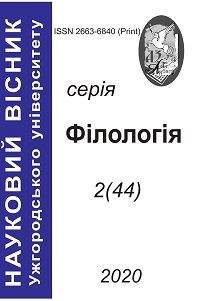COMPLEX COGNITIVE STUDY OF ENGLISH IDIOMS: А CASE OF EYE-UNITS
DOI:
https://doi.org/10.24144/2663-6840.2020.2.(44).276-281Ключові слова:
idiom, concept, image schema, categorization, conceptual metaphor, conceptual integration.Анотація
The paper suggests a complex cognitive model which reconstructs the formation of the idiomatic meaning on the intersection of the human faculties of perception, categorization, reasoning and memory with its two levels: linguistic and conceptual. The linguistic memory underlies the unity of form and meaning entrenched in the human mind enabling the identification of idioms as morphosyntactic constructions. The conceptual memory encompasses frames and concepts storing encyclopedic knowledge which underlies the creation of idiomatic meaning. Categorization establishes the belongingness of the basic-level entities to the same or different classes determining the application of the conceptual metaphor with the projection of the source domain onto the target domain or of the conceptual integration with two input spaces underlying the formation of the emergent semantics. The basic procedures of the creation of the idiomatic meaning are constrained by image schemas,
i.e. dynamic recurring patterns of organism-environment interaction: somatic, structuring the space around the human body; perceptual, rendering the changes of images obtained from a varying distance; sensory-motor, coding human handling of the physical objects; dynamic, representing motion and force interaction. The paper finds that in the case of the English eye-idioms the perceptual schemas determine the indication of the number of organs of vision: prototypical, i.e. two, and non-prototypical, represented by one eye or its half versus four eyes or their collection. It results in the formation of the idiomatic meanings which intensify human visual capacity or focus attention on perceived objects. In their turn, the perceptual relations are modified by sensory-motor schemas underlying the use of eyes to represent the inner states of the body and mind: physiological conditions, beliefs, understanding, emotions of pleasure or shock, human soul and imagination. The dynamic schemas underlie the idio- matic meaning based on human interaction with other entities which is accompanied by blocking / unblocking vision to render the concept of ignoring; by attracting viewers’ attention to express the idea of concentration; by symbolizing the opposition between human bodies.

